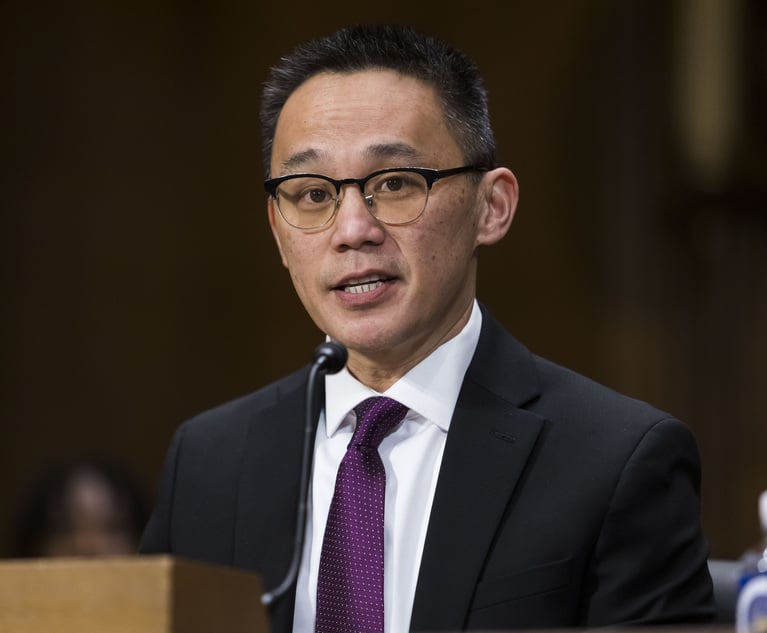 Lightspring/Shutterstock.com
Lightspring/Shutterstock.comWhy Lawyers Get Sued for Malpractice--And How to Prevent It
Common Causes of Legal Malpractice Lawsuits
September 03, 2019 at 01:00 AM
6 minute read
The original version of this story was published on Texas Lawyer
The American Bar Association reports that four out of five lawyers will get sued for malpractice at some point in their career. Seventy percent of malpractice claims are filed against small firms of one to five lawyers.
In terms of damaging a lawyer's reputation, requiring extra work hours, and incurring costly defense expenses, there are few things more daunting than being sued for legal malpractice.
Despite the obvious negatives of being targeted by a client, the same types of conduct account for most malpractice allegations year after year. Similarly, attorneys who handle a select few areas of law are more likely to face a malpractice claim compared to their peers.
Being aware of the common reasons clients decide to sue their lawyers and the areas of practice that represent potential minefields are just two ways attorneys can protect against being the subject of a malpractice lawsuit.
Who Gets Sued for Legal Malpractice?
Every year, the Virginia-based insurance brokerage and risk management firm Ames & Gough publishes a survey of professional liability insurance companies that, combined, provided insurance to roughly 80 percent of the firms listed in the Am Law 200.
The firm's 9th annual report released in 2018 found that, although claim frequency remained stable over the prior year, claim severity rose. All nine surveyed insurance carriers reported claims reserved at, or in excess of, $500,000, with five insurers reporting at least 21 such claims. Further, five carriers reported paying claims of $50 million or more, including two settlements that totaled in excess of $250 million.
As reported by the surveyed insurers, Ames & Gough identified four practice areas that account for nearly all the legal malpractice lawsuits filed during 2018, which has been consistent since the survey began: Business Transactions (63 percent); Trusts & Estates (55 percent); Corporate & Securities (45 percent); and Real Estate (45 percent).
Additionally, according to the American Bar Association, plaintiff's personal injury firms are at a higher risk as are attorneys practicing IP law and the newly emerging area of loan modification.
Most Common Legal Malpractice Claims
Once again, the Ames & Gough survey identified real and perceived conflicts of interest as the leading legal malpractice claim last year. In fact, conflicts have topped the list every year the survey has been conducted.
Many of the conflict problems are attributed to lateral hires or "merged" attorneys who allegedly are not properly trained or supervised. The conflict issue also is blamed on firms that fail to properly screen incoming attorneys to make sure their prior work does not put them in conflict with existing client matters.
Other common causes of legal malpractice lawsuits include:
- Failure to know or properly apply substantive law
- Missing statute of limitations
- Failing to calendar deadlines
- Missing a crucial filing date
- Inadequate investigation or fact discovery
- Administrative errors
- Intentional wrongdoing
- Failure to follow client instructions
- Failure to properly obtain client consent
In its 2017 survey, Ames & Gough reported that the costs of defending malpractice claims continued to rise with two of the insurers reporting average malpractice defense costs at more than $500,000 while the remaining seven companies said they averaged between $50,000 and $500,000. In other words, getting sued for malpractice is not an inexpensive proposition.
How to Prevent a Legal Malpractice Lawsuit
Since the causes of legal malpractice are readily identifiable, there are clear ways to reduce the risk of being sued by a client.
On the conflicts front, firms need to be hyper-vigilant when bringing in new attorneys to help lessen the chances that a client will claim a real or perceived conflict. This is especially true for law firms in Texas based on the recent influx of out-of-state firms and lawyers who have decided to set up shop in the Lone Star State.
Attorneys who are accused of failing to properly apply substantive law often are working in areas outside their expertise for one reason or the other. Unfortunately, some lawyers decide to "wing it" to help satisfy a client's immediate needs only to later find out that they were in over their heads. All told, it is much safer and better for the lawyer to refer a matter to another law firm with more expertise instead of trying to hold on to the work. This is a common problem for small firms trying to be a "one-stop shop" for their clients.
Another common thread in malpractice claims can be tied to poor communication with clients. If a client asks for information about their case, every law firm should make a good faith effort to respond in a timely manner. Ignoring a "pestering" client is a recipe for a grievance and potentially a legal malpractice lawsuit.
Although some lawyers have trouble admitting their mistakes, doing so can diffuse a potential malpractice claim. Owning up to a mistake and explaining what can be done to resolve the issue is not only ethically the right thing to do, it also shows clients that their attorneys are human and willing to resolve whatever problem their mistake caused.
Best practice is for a firm to immediately contact their malpractice insurer whenever they become aware of a possible claim. That does not mean waiting until a lawsuit is filed with a request for damages, which can only prolong the process. Most insurers will allow the filing of a "notice of circumstance," which can help ensure that firms are covered in the event of an actual malpractice lawsuit.
No one wants to be sued for legal malpractice. It is costly, time-consuming, and potentially damaging in terms of reputation and legal expenses. Knowing the rules and the areas that are most likely to result in a claim are the best tools to keep it from happening.
Brad Jackson is the founder of The Law Offices of Brad Jackson in Dallas. Jackson is Board Certified in Civil Trial Law by the Texas Board of Legal Specialization. He and fellow firm attorney Cheryl L. Mann regularly represent lawyers, law firms and individuals in legal malpractice lawsuits.
This content has been archived. It is available through our partners, LexisNexis® and Bloomberg Law.
To view this content, please continue to their sites.
Not a Lexis Subscriber?
Subscribe Now
Not a Bloomberg Law Subscriber?
Subscribe Now
NOT FOR REPRINT
© 2024 ALM Global, LLC, All Rights Reserved. Request academic re-use from www.copyright.com. All other uses, submit a request to [email protected]. For more information visit Asset & Logo Licensing.
You Might Like
View All
Should It Be Left to the Plaintiffs Bar to Enforce Judicial Privacy Laws?
7 minute read
A Reporter and a Mayor: Behind the Scenes During the Eric Adams Indictment News Cycle

Of Predictive Analytics and Robots: A First-Year Federal Judge's Thoughts on AI
Trending Stories
- 1Friday Newspaper
- 2Judge Denies Sean Combs Third Bail Bid, Citing Community Safety
- 3Republican FTC Commissioner: 'The Time for Rulemaking by the Biden-Harris FTC Is Over'
- 4NY Appellate Panel Cites Student's Disciplinary History While Sending Negligence Claim Against School District to Trial
- 5A Meta DIG and Its Nvidia Implications
Who Got The Work
Michael G. Bongiorno, Andrew Scott Dulberg and Elizabeth E. Driscoll from Wilmer Cutler Pickering Hale and Dorr have stepped in to represent Symbotic Inc., an A.I.-enabled technology platform that focuses on increasing supply chain efficiency, and other defendants in a pending shareholder derivative lawsuit. The case, filed Oct. 2 in Massachusetts District Court by the Brown Law Firm on behalf of Stephen Austen, accuses certain officers and directors of misleading investors in regard to Symbotic's potential for margin growth by failing to disclose that the company was not equipped to timely deploy its systems or manage expenses through project delays. The case, assigned to U.S. District Judge Nathaniel M. Gorton, is 1:24-cv-12522, Austen v. Cohen et al.
Who Got The Work
Edmund Polubinski and Marie Killmond of Davis Polk & Wardwell have entered appearances for data platform software development company MongoDB and other defendants in a pending shareholder derivative lawsuit. The action, filed Oct. 7 in New York Southern District Court by the Brown Law Firm, accuses the company's directors and/or officers of falsely expressing confidence in the company’s restructuring of its sales incentive plan and downplaying the severity of decreases in its upfront commitments. The case is 1:24-cv-07594, Roy v. Ittycheria et al.
Who Got The Work
Amy O. Bruchs and Kurt F. Ellison of Michael Best & Friedrich have entered appearances for Epic Systems Corp. in a pending employment discrimination lawsuit. The suit was filed Sept. 7 in Wisconsin Western District Court by Levine Eisberner LLC and Siri & Glimstad on behalf of a project manager who claims that he was wrongfully terminated after applying for a religious exemption to the defendant's COVID-19 vaccine mandate. The case, assigned to U.S. Magistrate Judge Anita Marie Boor, is 3:24-cv-00630, Secker, Nathan v. Epic Systems Corporation.
Who Got The Work
David X. Sullivan, Thomas J. Finn and Gregory A. Hall from McCarter & English have entered appearances for Sunrun Installation Services in a pending civil rights lawsuit. The complaint was filed Sept. 4 in Connecticut District Court by attorney Robert M. Berke on behalf of former employee George Edward Steins, who was arrested and charged with employing an unregistered home improvement salesperson. The complaint alleges that had Sunrun informed the Connecticut Department of Consumer Protection that the plaintiff's employment had ended in 2017 and that he no longer held Sunrun's home improvement contractor license, he would not have been hit with charges, which were dismissed in May 2024. The case, assigned to U.S. District Judge Jeffrey A. Meyer, is 3:24-cv-01423, Steins v. Sunrun, Inc. et al.
Who Got The Work
Greenberg Traurig shareholder Joshua L. Raskin has entered an appearance for boohoo.com UK Ltd. in a pending patent infringement lawsuit. The suit, filed Sept. 3 in Texas Eastern District Court by Rozier Hardt McDonough on behalf of Alto Dynamics, asserts five patents related to an online shopping platform. The case, assigned to U.S. District Judge Rodney Gilstrap, is 2:24-cv-00719, Alto Dynamics, LLC v. boohoo.com UK Limited.
Featured Firms
Law Offices of Gary Martin Hays & Associates, P.C.
(470) 294-1674
Law Offices of Mark E. Salomone
(857) 444-6468
Smith & Hassler
(713) 739-1250







